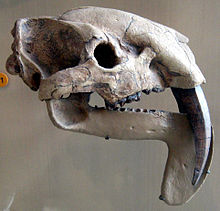Thylacosmilus
| Thylacosmilus Temporal range:
| |
|---|---|

| |
| skull cast: Original is P 14531 in the collections of the Field Museum of Natural History | |
| Scientific classification | |
| Kingdom: | |
| Phylum: | |
| Class: | |
| Infraclass: | |
| Order: | |
| Family: | |
| Genus: | †Thylacosmilus |
| Species: | T. atrox
|
| Binomial name | |
| Thylacosmilus atrox Riggs, 1933
| |
| Synonyms | |
|
T. lentis Riggs, 1933 | |
Thylacosmilus atrox is an extinct species of saber-toothed metatherian that inhabited South America from the late Miocene to late Pliocene epochs. Remains of this animal have been found primarily in the provinces of Catamarca, Entre Ríos, and La Pampa in northern Argentina.[2] Though Thylacosmilus is one of several predatory mammal genera typically called "sabre-toothed cats", it was not a felid but a sparassodont, a group closely related to marsupials, and only superficially resembled other sabre-toothed mammals due to convergent evolution.
Description

The most notable features of Thylacosmilus that can be identified were its canines, which were saber-like and whose roots grew throughout the animal’s life, growing in an arc up the maxilla and even above the orbits.[3] Its cervical vertebrae were very strong and to some extent resembled the vertebrae of machairodonts.[4] Recent comparative biomechanical analysis have estimated the bite force of T. atrox starting at maximum gape at 38 newtons (8.5 lbf), much weaker than that of a leopard, suggesting its jaw muscles had an insignificant role in the dispatch of prey. Its skull was similar to that of Smilodon in that it was much better adapted to withstand loads applied by the neck musculature, which, along with evidence for powerful and flexible forelimb musculature and other skeleton adaptations for stability, support the hypothesis that its killing method consisted on immobilization of its prey followed by precisely directed, deep bites into the soft tissue driven by powerful neck muscles.[5][6]
Body mass estimates of Thylacosmilus suggest this animal weighed between 80 and 120 kg (170 and 260 lb), about the same size as a modern jaguar.[7][8] This would make it one of the largest known carnivorous metatherians.
Extinction
Although older references have often stated that Thylacosmilus went extinct due to competition with the “more competitive” saber-toothed cat Smilodon during the Great American Biotic Interchange, newer studies have shown this is not the case. Thylacosmilus died out during the late Pliocene, whereas saber-toothed cats are not known from South America until the middle Pleistocene epoch.[7] As a result, the last appearance of Thylacosmilus is separated from the first appearance of Smilodon by over one and a half million years.
References
- ^ Riggs, E.C. 1934: A new marsupial saber-tooth from the Pliocene of Argentina and its relationships to other South American predacious marsupials. Transactions of the American Philosophical Society 24, 1–32.
- ^ Forasiepi, Analía M. (2009). "Osteology of Arctodictis sinclairi (Mammalia, Metatheria, Sparassodonta) and phylogeny of Cenozoic metatherian carnivores from South America". Monografías del Museo Argentino de Ciencias Naturales. 6: 1–174.
- ^ Antón, Mauricio (2013). Sabertooth. Bloomington, Indiana: Indiana University Press. ISBN 9780253010421.
- ^ Benes, Josef. Prehistoric Animals and Plants. Prague, Artua, 1979. Pg. 237-8
- ^ Hogenboom, M. (2013-07-02). "Sabretooth killing power depended on thick neck". BBC. Retrieved 2013-08-03.
- ^ Wroe, S; Chamoli, U; Parr, WCH; Clausen, P; Ridgely, R (2013-06-26). "Comparative Biomechanical Modeling of Metatherian and Placental Saber-Tooths: A Different Kind of Bite for an Extreme Pouched Predator". PLoS ONE. 8 (6). doi:10.1371/journal.pone.0066888.
{{cite journal}}: CS1 maint: unflagged free DOI (link) - ^ a b Prevosti, Francisco J.; Analia Forasiepi; Natalia Zimicz (2013). "The Evolution of the Cenozoic Terrestrial Mammalian Predator Guild in South America: Competition or Replacement?". Journal of Mammalian Evolution. 20: 3–21. doi:10.1007/s10914-011-9175-9.
- ^ Ercoli, Marcos D.; Francisco J. Prevosti (2011). "Estimacion de masa de las especies de Sparassodonta (Mammalia, Metatheria) de edad Santacrucense (Mioceno Temprano) a partir del tamano del centroide de los elementos apendiculares: inferencias paleoecologicas". Ameghiniana. 48: 462–479. doi:10.5710/amgh.v48i4.347.
- Evolution of the Earth by Donald R. Prothero, Jr., Robert H. Dott, Donald Prothero, and Jr., Robert Dott
- The Earth Through Time by Harold L. Levin
- Bringing Fossils To Life: An Introduction To Paleobiology by Donald R. Prothero
